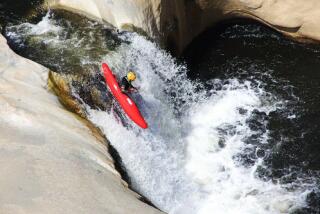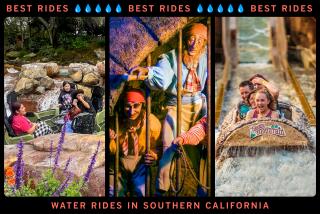White Water Adventurers Defy Death by Rafting Earth’s Deepest Canyon : Water sports: Peru’s Colca Canyon is a chasm up to 10,500 feet deep carved by a river that races 236 miles from the Andes to the Pacific.
The only thing Joe Kane remembers clearly about running Gutter Rapid is that at some point he had part of somebody’s head in his mouth.
“Oh, we had picked out a line of attack, of course,” Kane writes in the National Geographic about his kayak-and-raft tumble down Peru’s fearsome Colca Canyon, the deepest chasm on Earth.
First they were to pass a big rock on the right--advice from Colca veteran Piotr Chmielinski. Then they were to paddle left, left, left hard, then straight. Then, “no problem,” Chmielinski had assured his teammates.
“That all flew out the door when our raft floor exploded,” Kane writes. “No one had seen the razor-tipped rock just below the surface.”
*
Kane had known of the dangers involved when he decided to join the handful of people in the world who have ever seen the heart of the Colca. Not all have lived to tell about it. Kane and 11 friends endured 11 days of intermittent joy and terror on a river where a mistake or an unlucky bounce off a boulder can snuff out a life.
Rising in the southern Peruvian Andes and spilling southwest for 236 miles before emptying into the Pacific, the river carves a gorge that, measured from its lower rim, is 10,500 feet deep--more than twice as deep as Arizona’s Grand Canyon.
Before the Colca, Kane had run only one river: the Amazon, from source to mouth, by foot, raft and kayak. Although he calls that the “looniest thing I’d ever done,” he found himself haunted by the experience and by Peru, “one of the most startlingly beautiful places in the Western Hemisphere.
“Flexing against such memories, my soul renewed itself. I came to believe that at times risk is the price you pay to reach a place that can blast your spirit clean.”
On the second day of the trip, the raft was slashed open, sliced by a sharp, unseen rock in a gorge where the entire river squeezed through one massive chute. It careened between house-size boulders, then dumped into a “hole,” a savage vortex of churning water.
“I felt a tickling under my feet as the raft hit the chute and shot over something hard,” Kane writes. “Then there was a sound like a rocket firing, and we went ballistic. I do remember the sensation of being suspended right over the hole, inches from this howling white being that wanted to eat me alive, and somewhere I could hear Piotr screaming ‘Go-Go-Go-Go!’ and Johnny (Moscarillo) screaming back: ‘We are dead meat!’ ”
Then, “somehow I was on top of Johnny and the river was on top of us. The raft stood on its side, Piotr yelling ‘Up-Up-Up!’ and we climbed the high side to force it down, then we walloped something head-on, and I was on my way out the front end. But then suddenly the world decelerated and there we were, floating in smooth calm water laughing like hyenas.”
On the seventh day, after many thrills and close calls, Kane fell out of the boat while going over a waterfall.
“Basically we went over the falls completely out of control and the raft hit the hole and stuck, pounded into place by the full force of the river,” Kane writes. “It bucked wildly and for a brief second stood me straight up. Then something sucked the legs out from under me. I struggled to keep my balance but lost and went right over the side.”
For two months before the trip, Kane had gone swimming every day, anticipating just such a moment. He would force himself to swim underwater until he knew he would pass out, then swim two more strokes, trying to tame the constricted panic of drowning.
“I never succeeded, and as I went underwater at Canoandes, I relived that terror. It was like one of those stomach-churning carnival rides, but with no guarantee it would stop. I whirled and spun. I went limp--no use fighting it. I waited. And I waited. And I waited, helpless, while the river beat me at will.”
Then, for no apparent reason, he came up.
“A rescue line floated on the surface. I grabbed it and found a grinning Andrzej (Pietowski) hauling me up to a boulder.”
The final test was Poles’ Canyon, “a narrow, thunderous maze of undercut rock and crisscrossing currents--in short, a death trap,” Kane writes.
The rafters portaged two-thirds of the way down the drop before room to walk disappeared, leaving them no choice but to run the rest of the rapid. Kane and his teammates positioned their raft carefully at a point where the river raged inches below the bow. Should they launch more than two feet off course, they would be thrashed to a watery grave.
“It comes down to this: six strokes,” Kane writes. “Execute them correctly, we’re home free; make a mistake, we’re dead. I’m terrified. Even the portage, shimmying along sheer faces directly above the torrents, was unnerving. But in truth there’s nowhere else I’d rather be. If we make it, yes, there will be sweet memories. The bonds of friendship will draw even tighter, and as old men we will meet and drink beer and say, ‘Remember the Colca?’
“But it’s more than that--much more. I can no longer tell the sound of my own breath from the roar of the river. This rogue canyon has pushed and prodded and pounded me until I understand eternal secrets: Rock lives. Water lives. Earth lives. If soon I die--so? In this moment I am fully alive, alive forever.”
All is white as they plunge forward.
“We glance off a boulder, twist, straighten out. We race through white toward a long green tongue. I look up: Far downriver I see walls pulling back and sunlight touching water; I see safe passage home from this glorious, wrecked place.”
More to Read
Sign up for The Wild
We’ll help you find the best places to hike, bike and run, as well as the perfect silent spots for meditation and yoga.
You may occasionally receive promotional content from the Los Angeles Times.






